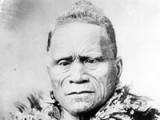What happened that day?
See historic events for any day of the year by entering the date below. Why not try your birthday?
Kiwi of the Week
Today in History

1894 Death of second Maori King
As the second Maori King, Tukaroto Matutaera Potatau Te Wherowhero Tawhiao had led his people through the traumatic period during and after the wars of the 1860s. He was buried at Taupiri after a tangihanga in September that was attended by thousands. Tawhiao was succeeded as King by his son Mahuta.
Tawhiao left a legacy of religious principles from which his people would draw a future dream for Tainui: the rebirth of a self-sufficient economic base, supported by the strength and stability of the people. Native trees and foods symbolised strength and self-sufficiency in his statement: 'I shall build my own house, the ridge-pole will be of hinau and the supporting posts of mahoe and patate. Those who inhabit that house shall be raised on rengarenga and nurtured on kawariki.'
During Tawhiao's exile in the 'King Country', Waikato people had reflected and focused on the powerful symbols of the King movement. The man and the vision became united and formed part of the traditions and knowledge of the people. The vision is recounted and passed on to later generations at tribal hui, where it continues to be discussed and debated.














